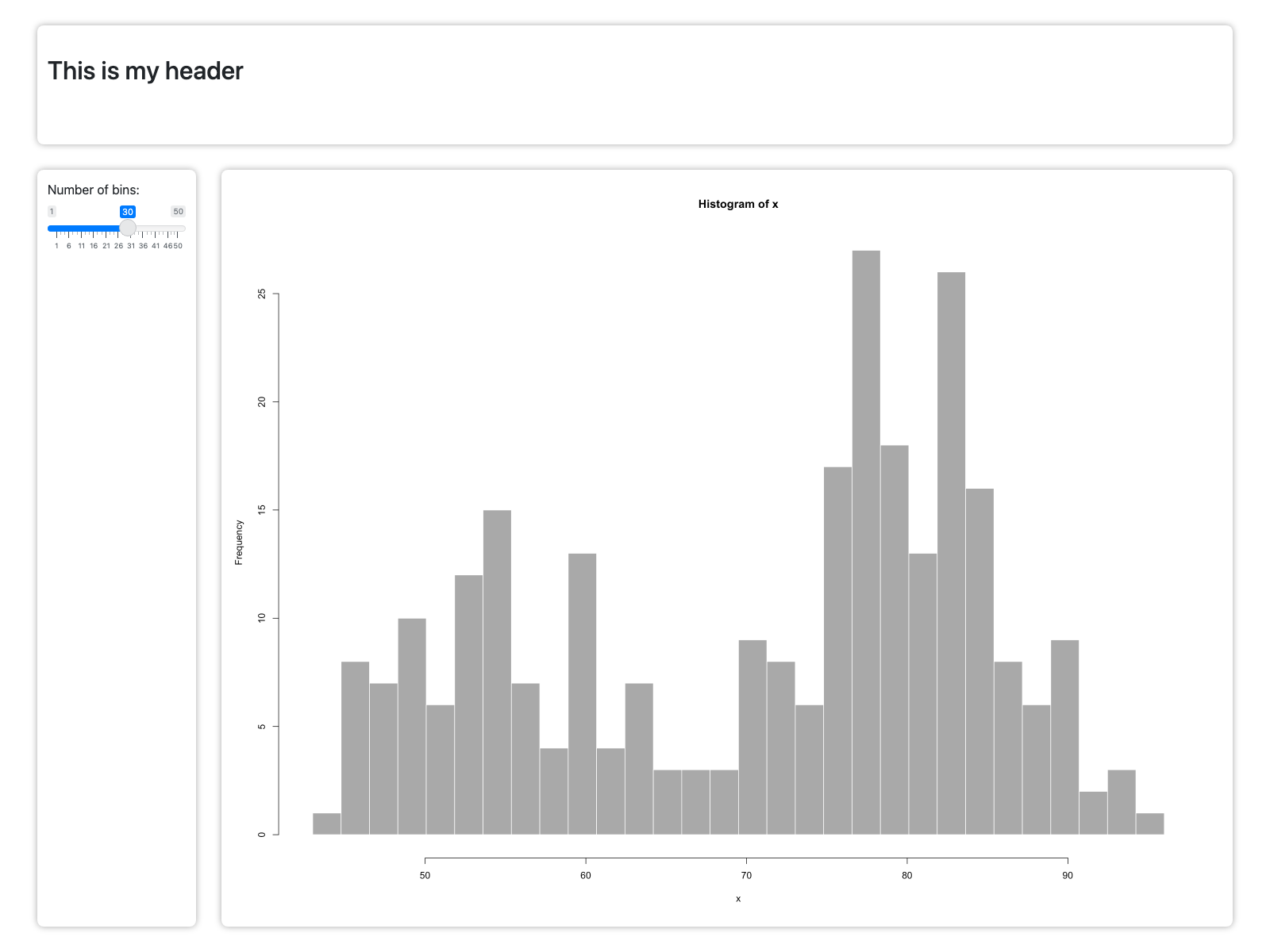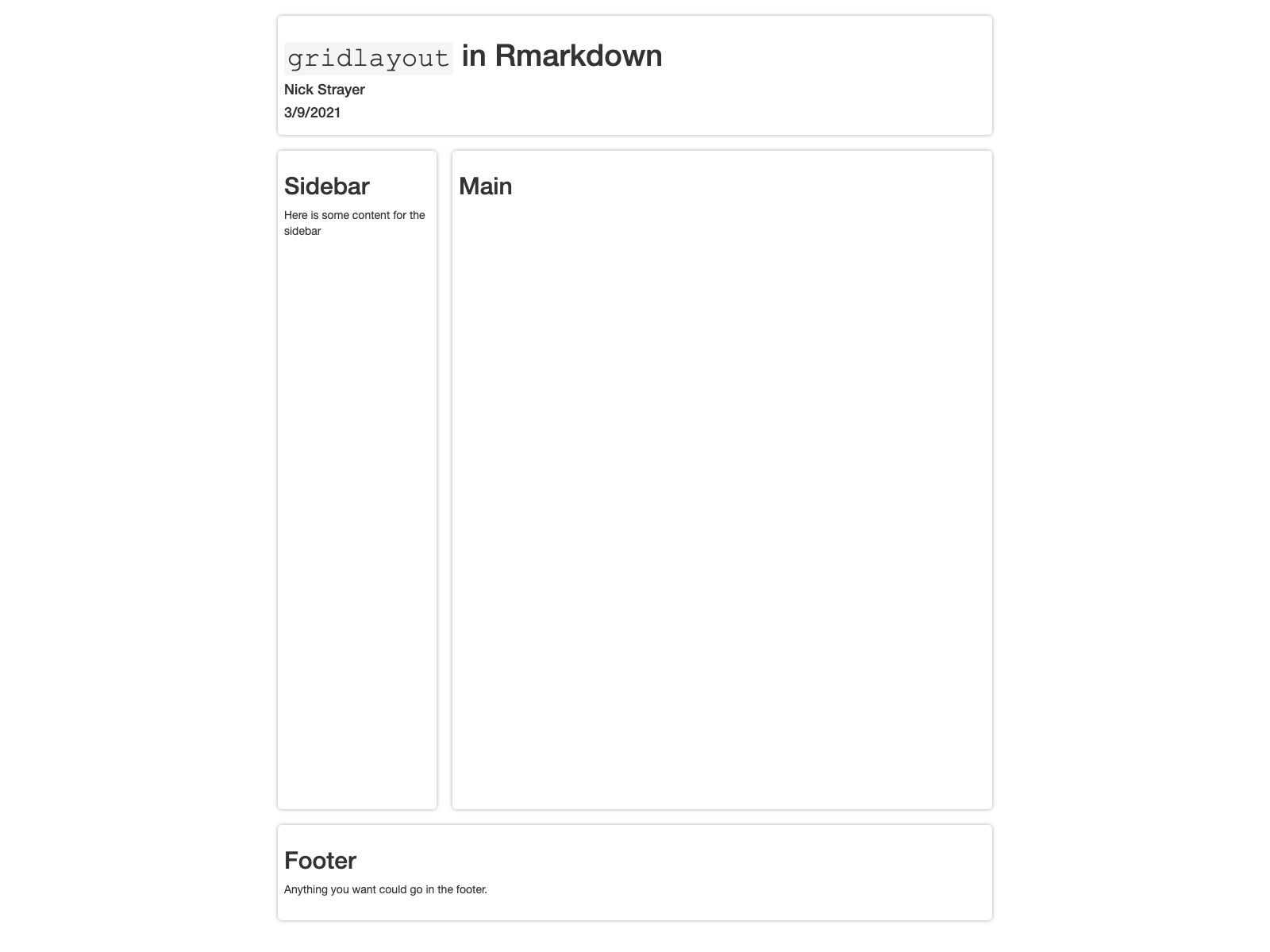Build dashboard-style layouts for Shiny and RMarkdown easily using CSS-Grid.
Installation
You can install the development version from GitHub with:
# install.packages("devtools")
devtools::install_github("rstudio/gridlayout")Setting up your gridlayout
The easiest and most common way to specify a grid layout is using an character vector syntax where the elements in your layout are visually lined up making the general gist of the layout clear at a glance.
library(gridlayout)
my_layout <- new_gridlayout(c(
" 120px 1fr 1fr ",
"100px header header header",
"1fr sidebar plot_a plot_c",
"1fr sidebar plot_b plot_b"
))
my_layout
#> gridlayout of 5 elements:
#> 120px 1fr 1fr
#> 100px header header header
#> 1fr sidebar plot_a plot_c
#> 1fr sidebar plot_b plot_b
#> Gap of 12px. Total height of viewport.
#>
#> Alternate layouts:
#>
#> - Width < 500px
#> 1fr
#> 85px header
#> 350px sidebar
#> 350px plot_a
#> 350px plot_b
#> 350px plot_c
#> Gap of 12px. Total height of auto.For more info and alternative ways of defining a layout see vignette("defining-a-layout", package = "gridlayout").
Using in a shiny app
Once you’ve setup your layout, the easiest way you can use it in your shiny apps is with the grid_page() ui function:
library(shiny)
library(bslib)
# The classic Geyser app with grid layout
shinyApp(
ui = grid_page(
layout = c(
" 200px 1fr ",
"85px header header",
"1fr sidebar plot "
),
grid_card_text("header", "Geysers!", is_title = TRUE),
grid_card(
"sidebar",
card_header("Settings"),
sliderInput("bins","Number of bins:",
min = 1, max = 50, value = 30, width = "100%")
),
grid_card(
"plot",
card_body(
plotOutput("distPlot")
)
)
),
server = function(input, output) {
output$distPlot <- renderPlot({
x <- faithful[, 2]
bins <- seq(min(x), max(x), length.out = input$bins + 1)
hist(x, breaks = bins, col = 'darkgray', border = 'white')
})
}
) Screenshot of grided geyser app running
Screenshot of grided geyser app running
Other ways of using gridlayout in your app
grid_page() will automatically make your gridlayout fill the entire page. If you are interested in having a finer-grain control over the size and position of your grid layout you can use the grid_container() function to place your grid layout wherever you want. The equivalent app to above can be created by replacing the UI definition with a fluidPage containing a grid_container():
...
shinyApp(
ui = fluidPage(
grid_container(
layout = c(
" 200px 1fr ",
"85px header header",
"1fr sidebar plot "
),
grid_card_text("header", "Geysers!"),
grid_card(
"sidebar",
card_header("Settings"),
sliderInput("bins", "Number of bins:",
min = 1, max = 50, value = 30, width = "100%")
),
grid_card(
"plot",
card_body(
plotOutput("distPlot")
)
)
)
),
server = ...
)This time, however the grid is constrained to 800px tall, no-matter how large or small the window viewing it is.
Alternatively you can use grid_nested() to use a gridlayout layout within a panel another gridlayout.
...
shinyApp(
ui = grid_page(
layout = c(
" 250px 1fr ",
"50px header header",
"1fr sidebar plots "
),
grid_card_text("header", "This is my header"),
grid_card(
"sidebar",
card_header("Settings"),
sliderInput("bins", "Number of bins:", min = 1, max = 50, value = 30, width = "100%")
),
grid_nested(
"plots",
title = "Plots - in technicolor",
layout = c(
"distPlot distPlot distPlot",
"redPlot bluePlot greenPlot"
),
grid_card_plot("distPlot"),
grid_card_plot("redPlot"),
grid_card_plot("bluePlot"),
grid_card_plot("greenPlot")
),
server = ...
)Using in RMarkdown
The function use_gridlayout_rmd() called in the setup chunk of an RMarkdown file will enable you to use gridlayout to layout your document. Just match the section headers to the layout element names and place layout md table in a gridlayout chunk…
my_app.rmd
---
title: "`gridlayout` in Rmarkdown"
author: "Nick Strayer"
date: "3/9/2021"
output: html_document
---
## Main
```gridlayout
| | | |
|------|--------|---------|
|2rem |200px |1fr |
|150px |header |header |
|1fr |sidebar |main |
|120px |footer |footer |
```
## Sidebar
Here is some content for the sidebar
## Footer
Anything you want could go in the footer.
Output of my_app.rmd